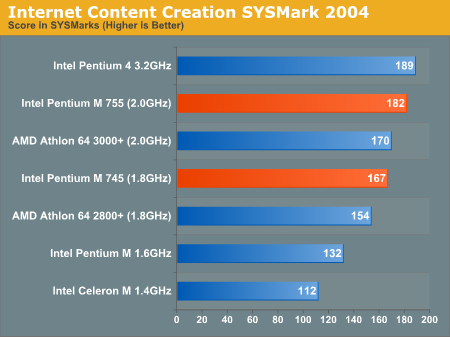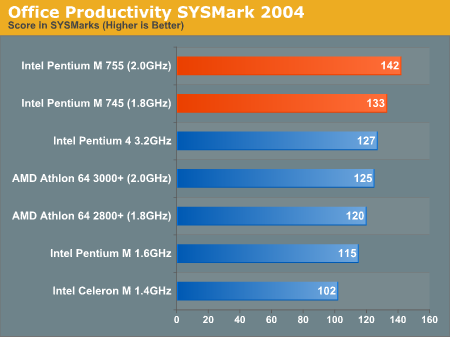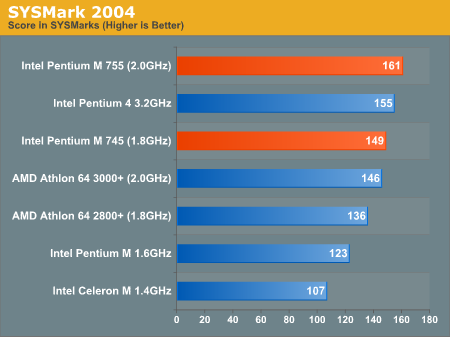Intel's 90nm Pentium M 755: Dothan Investigated
by Anand Lal Shimpi on July 21, 2004 12:05 AM EST- Posted in
- CPUs
General Usage Performance - SYSMark 2004
Like the Winstone tests, SYSMark is an important suite to look at as this is how most users will use their notebooks. Just like Winstone, SYSMark is divided into both office and content creation suites; let's have a look.This time, we look at content creation performance first. Here's what happens with the Internet Content Creation suite:
"In this scenario, the content creator creates a product-related website targeting a broadband and narrowband audience. The user first renders a 3D model to a bitmap, while preparing web pages using a web site publishing tool. The user opens a video editing package, creates a movie from several raw input movie cuts and sound cuts and starts exporting it. While waiting on this operation, the user imports the rendered image into an image-processing package, modifies it and saves the results. Back in the 3D modeling software, the user modifies a 3D model and exports it to a vector-graphics format. Once the movie is assembled, the user edits it and creates special effects using one of the modified images as input. The user extracts content from an archive. Meanwhile, he uses an animation creation tool to open the exported 3D vector graphics file. He modifies it by including other pictures and optimizes it for faster animation. The final movie with the special effects is then compressed in a format that can be broadcast over broadband Internet. The web site is given the final touches and the system is scanned for viruses."

ICC SYSMark 2004 has always favored Intel processors; more specifically, the Pentium 4. Under the older SYSMark 2002 benchmark, this was the only test where the Pentium M could not hang with its older brother. This time around, we see that the Banias based Pentium M doesn't fair well at all, but with a few architectural tweaks, twice the cache and a higher clock speed, the Pentium M 755 is nipping at the heels of the Pentium 4.
The Pentium M also manages to outperform the Athlon 64, but that is to be expected here; once again, SYSMark has always favored Intel processors.
Next, we have the Office Productivity suite:
"In this scenario, the office productivity user creates a marketing presentation and supporting documents for a new product. The user receives email containing a collection of documents in a compressed file. The user reviews his email and updates his calendar while a virus checking software scans the system. The corporate web site is viewed and the user begins creating the collateral documents. The user also accesses a database and runs some queries. A collection of documents are compressed. The queries' results are imported into a spreadsheet and used to generate graphical charts. The user then transcribes a document. Once the document has all the necessary pieces in place, the user changes it into a portable format for easy and secure distribution. The user edits and adds elements to a slide show template. Finally, the user looks at the results of his work (both the slide show and the portable document) in an Internet browser. "

Here, the Dothan based Pentium M 755 manages to outperform the Pentium 4 3.2 and the Athlon 64 3000+, both by a significant margin. Further echoing our results from Winstone, it's clear that for business users, the new Pentium M is the king of the hill when it comes to mobile computing.
The overall SYSMark graph takes both ICC and Office Productivity performance into account. For reference, we show it below:











28 Comments
View All Comments
eBauer - Friday, November 19, 2004 - link
I'd like to see a P4 3.2-3.4 w/ dual channel DDR3200 used instead of single channel DDR2700 that was used for the P4 testbed - as a rough idea where a Dell 9100/XPS, for example, would fall in line with the Dothan.bhtooefr - Saturday, July 24, 2004 - link
Something else I noticed - where's the Banias 1.7 and the Dothan 735? It would make comparing Banias to Dothan so much easier to do that...Also, what motherboards did you use on the desktop chips?
#25: Take a look at http://cpu-museum.de/forum/viewtopic.php?t=1089. PowerLeap actually DID have something in the works, and was going to release in Quarter 1, but they cancelled it because of (well, at least this is what they said - I wouldn't be surprised if it was because Intel held them at gunpoint) LGA775 coming out (which can't really work with an adaptor) and the fact that the P-M wasn't running at 2.0GHz (I told them about Dothan, though).
Zebo - Saturday, July 24, 2004 - link
What are you talking about #4 and #17?Intels "dominace" in encoding? Those days are history my friends. If they ever were.
Anandtech's article published just before this one was proves it. Here's a quote:
"It was difficult to resist being a little sensationalist in this 939 roundup and titling the review, "Who needs 925X?" That would have been a fair title, however, since you can clearly see that all of the Socket 939/FX53 boards completely outperform Intel's top 560 on the top 925X motherboard. Even Media Encoding, the last bastion of Intel dominance, has fallen in benchmarks with our new AutoGK benchmark. "
As a matter of a fact it's always been a mismoner if you look at other suites/Codecs such as:
Codecs: xVID
Consumer programs: Ulead VideoStudio 4,5,6 and 7. Roxio videowave 4,5,6 and 7. Pinnacle studio 7.
MPEG2 Encoders: Canopus procoder, Ligos, bbMPEG.
DVD transcoding: DVD2AVI, VirtualDubMod
Freeware: VirtualDub.
Streaming: Quicktime.
Shot out to alex;)
T8000 - Thursday, July 22, 2004 - link
Since the Pentium M shares its bus protocol with the Pentium 4, I think companies like Powerleap should be more then able to provide an adaptor for desktop use.This would likely result in an "Intel unknown" detection, along with a lack of power save options, but previous experience with the "Tualatin" P3(1400) learned that this could work and even offer full performance compared to a full recognition.
Also, I think the limited memory bandwith did not hold Athlon 64 back, because I still remember seeing Athlon FX (dual channel) and 64 (sinle channel) perform almost equal for the same clockspeed. However, the Pentium 4 would benefit from more bandwith, as happened before on every FSB bump it got. So I think adding faster memory would only make a noticeable difference for the Pentium 4.
SKiller - Thursday, July 22, 2004 - link
I didn't say it would make up *all* the performance, but enough to make it competetive. For example: the P4 is essentially faster than A64 in those tasks but the A64 is still sufficiently close to be a viable altermative. Dothan doesn't have to beat the P4 in media encoding or content creation, just come close enough to be a good desktop CPU. It should be possible by increasing the FSB.Xentropy - Thursday, July 22, 2004 - link
#3 - "As you'd expect from 90nm, the leakage power has shot right up, meaning that in its low power states, the CPU is draining a great deal more power than Banias."Oh? Link to more info on this, please.
TrogdorJW - Wednesday, July 21, 2004 - link
One comment I forgot to mention: even with the talk of thermal design targets and clock speed limitations, I imagine that a Dothan CPU in a desktop motherboard with a large copper heatsink would have quite a lot of overclocking headroom. I know there was a French site that claimed to have overclocked a Dothan to 2.4 GHz, and the performance was quite impressive (if true). I would really like to see overclocking results for Dothan (and Banias) on a desktop system. With processors designed to generate 1/4 the amount of heat of a P4 3.2+, it could be interesting. Here's hoping some motherboard manufacturers will accommodate us! :)TrogdorJW - Wednesday, July 21, 2004 - link
Overall, I thought this was a great article. Those complaining about various configuration issues need to stop whining. Never once did AT actually give out any numbers for battery life or low-power performance, or claim that the Dothan was beating a desktop Athlon 64/P4. All we're looking at is what the various can do in typical *laptop* configurations. Getting a P4 and A64 laptop would make them into real laptops, but then we would have the laptop manufacturer's configuration, and likely it wouldn't be the same as what they had for the Dothan system. What we've got is three platforms running the same RAM, Hard Drive, and graphics card. Yes, it's limiting what some of the CPUs could do, but it's about as fair as you can get.Of course, if history is any indication, I'm fairly confident that Dothan is going to dominate other mobile architectures in battery life - when using the same screen, hard drive, and battery. Too bad it's so difficult to actually meet those criteria. Screens differ quite a bit, and many P4 and A64 laptops are shipping with 90+ kWhrs batteries, while Banias and Dothan laptops often get by with 60 to 70 kWhrs. Anyway, the Banias was generally the best laptop CPU before (i.e. most efficient while still providing good performance), so why shouldn't the Dothan be similar if not better? The results are hardly surprising.
I really hope that we one day see some desktop boards designed for Dothan, though. I imagine that getting the FSB up to 200 MHz quad-pumped should be possible, although even 133 or 166 would be helpful. Combine a Dothan CPU with all the other desktop accoutrements, and it would likely be a formidable gaming platform. Of course, it would really only be about the same as Athlon 64, and Intel is currently milking the Dothan/Banias line for all they can. $600+ for a processor that probably costs Intel less money to create than their P4 chips.
Again, great article, Anand. (And for the interested, Jon "Hannibal" Stokes over at Ars Technica put together as much information as I've seen anywhere about how the internals of the Banias/Dothan function. Not much detail in comparison to other CPU comparision articles he's written, but there is some additional information about what ops can benefit from the fusion technique, IIRC.)
rocketbuddha - Wednesday, July 21, 2004 - link
Acer(for sure) & Emachines(AFAIK) use a 4200 RPM HDD not a 5400 RPM HDD.The problem is that the available Athlon laptops are castrated in some level
a) Poor Graphics card(This changed with A64).
b) Lower speed HDDs.(Of course Aleinware, FNW fix with high end components pricing goes to the roof.)
c) Only 4 from a list of 32 varying modes by PowerNow!
With these either of these three there no way would a mobile A64 laptop would be in its best form for comparision.
SnakeJG - Wednesday, July 21, 2004 - link
I would also like to see this review updated with an Athlon 64 with 1 meg L2 cache. It seems a shame to compare an expensive 2 meg L2 cache Dothan with the cheaper 512KB L2 cache Athlon 64's. In addition, by keeping Athlon 64's to the slower/single channel RAM, you are making the L2 cache more important than normal, and hindering the Athlon 64.